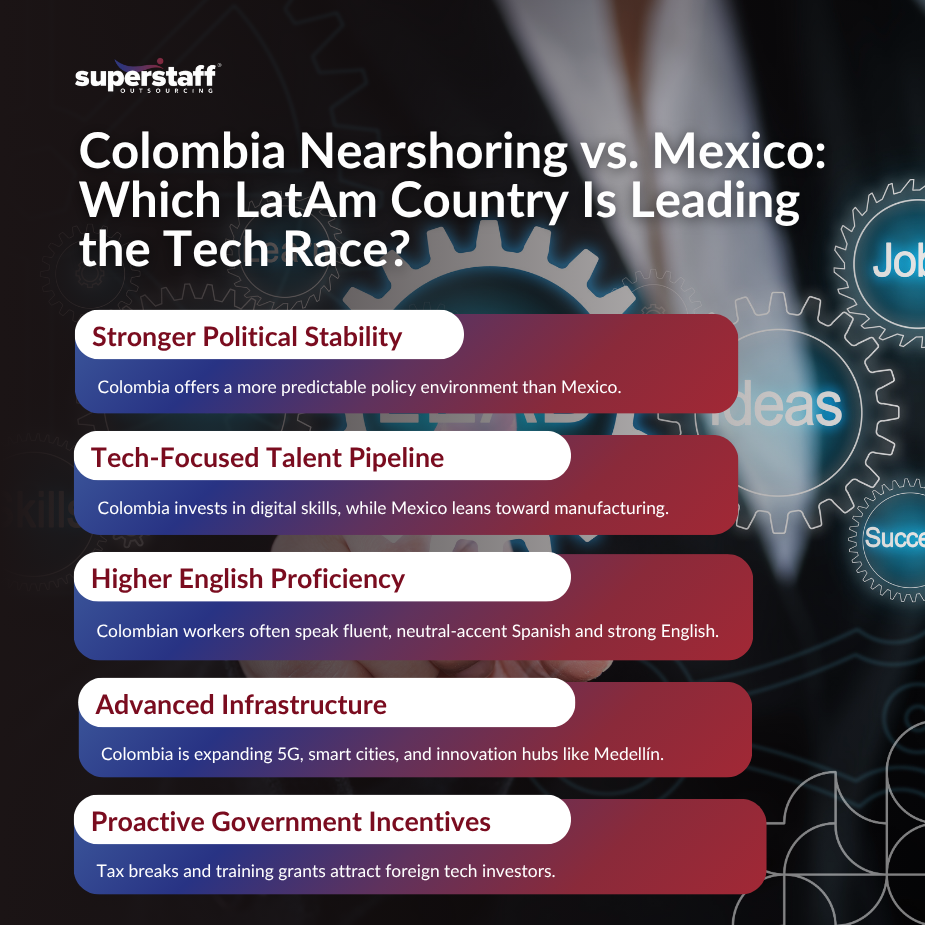
As tech companies across the U.S. rethink their global strategies, Latin America has emerged as the nearshoring capital of the decade. With the need for real-time collaboration, cultural compatibility, and cost-effective innovation, U.S. firms are turning south—not across oceans—for their next growth move. Traditionally, Mexico has held the top spot in this space, offering proximity and a large labor pool. But in 2025, the conversation around Colombia nearshoring is getting louder—and for good reason.
From government-backed digital training programs to major foreign investment deals, Colombia is accelerating its ascent in the tech outsourcing race. While Mexico remains a key player, Colombia is offering something new: a more agile, digitally fluent, and politically stable alternative for companies scaling fast. This isn’t just a game of catch-up. Colombia is rewriting the nearshoring playbook—and it’s starting to lead.
The Rise of Colombia Nearshoring: Why the LatAm Nation’s Strategic Advantage Is Growing
Colombia is leveraging major trade alliances and political neutrality to appeal to global tech players.
While Mexico has long benefited from trade agreements like USMCA, Colombia is playing a different hand. As a member of the BRICS Development Bank and China’s Belt and Road Initiative, the country has diversified its economic alliances beyond the Americas. Yet, it has maintained strong diplomatic and trade relations with the U.S., creating a rare geopolitical sweet spot. This diplomatic balancing act is proving attractive to U.S. and European tech firms that want access to emerging markets without betting too heavily on China.
Colombia is also seeing an influx of foreign direct investment from Asia and Europe, especially in the technology and infrastructure sectors. In contrast, Mexico faces increasing scrutiny due to its protectionist tendencies and the growing perception of economic instability.
Beyond geopolitics, Colombia’s domestic conditions also offer a smoother path for nearshore operations.
Political and Economic Stability Tips the Scale
Colombia’s policy stability in 2025 is positioning it as a safer, more predictable nearshore partner.
Over the past two years, the Colombian government has rolled out tax incentives designed to attract foreign investors in tech, BPO, and R&D. These reforms include simplified processes for launching IT operations and grants for companies that employ and train young digital workers. The result? Colombia’s regulatory environment is increasingly seen as pro-business and innovation-forward.
In contrast, Mexico’s ongoing struggles with organized crime, political volatility, and disruptions to supply chains have caused concern. These issues have tangible impacts on business continuity—from increased insurance costs to employee safety risks.
Colombia nearshoring ranks higher in recent “ease of doing business” indexes within the region and boasts faster turnaround times for permits, corporate registrations, and compliance processes.
But it’s not just about risk—Colombia is also winning in talent.

Colombia’s Talent Pipeline Is Purpose-Built for Tech
With aggressive investment in digital skills training, Colombia is producing a nearshore tech workforce at scale.
Government initiatives like MinTIC, Ruta N, and Innpulsa have created fertile ground for tech upskilling. These public-private programs collaborate with universities, bootcamps, and global tech firms to train young Colombians in coding, cybersecurity, AI, and data analytics. Cities like Bogotá, Medellín, and Cali have become vibrant talent hubs.
Colombia’s youth demographics offer a demographic edge over Mexico. A younger workforce, coupled with high English proficiency and neutral Spanish accents, make the country ideal for both North American and LATAM tech support roles.
Where Mexico’s workforce is more heavily skewed toward manufacturing and traditional BPO functions, Colombia is building a digital-first talent pipeline optimized for IT outsourcing. Colombia call centers are evolving beyond voice services into omnichannel, multilingual support roles that blend CX with technical troubleshooting—a huge plus for SaaS and fintech clients.
These workforce gains are being matched by infrastructure investments.
Infrastructure and Innovation Hubs Fuel the Surge
Colombia is investing in smart city development and digital infrastructure to support global tech delivery.
Medellín’s transformation into Latin America’s “Silicon Valley” is a flagship example. With smart mobility, sustainable energy, and city-wide Wi-Fi projects, it’s a proving ground for global innovation pilots. The city’s Ruta N complex connects startups, investors, and academia to support tech-focused ecosystems.
5G rollout is expanding rapidly across urban centers, and fiber-optic internet coverage has increased by over 30% since 2022, enabling secure and fast connectivity essential for remote work and cloud operations. Tech parks and accelerator programs, often funded by public-private partnerships, have begun to replace traditional industrial zones in urban planning.
By comparison, Mexico’s tech hubs remain fragmented. Although cities like Guadalajara and Monterrey are tech-friendly, they haven’t matched the cohesive urban innovation seen in Medellín.
All of these factors are showing up in real business shifts, fueling the rise of Colombia nearshoring for tech projects.
U.S. Companies Are Taking Notice — and Making Moves
The proof is in the partnerships: Colombia is onboarding more U.S. tech clients looking to scale fast.
Several major SaaS companies and midsize tech firms have opened Colombia-based delivery centers in the past 18 months. These include IT outsourcing Colombia operations spanning helpdesk, QA testing, full-stack development, and customer success roles. The feedback? High retention, low attrition, and cultural synergy with U.S. teams.
Client testimonials highlight the professionalism and skill depth of Colombian teams, often noting how quickly they ramp up and integrate with in-house operations. Some companies that once experimented with outsourcing in Mexico have pivoted entirely to Colombia due to a smoother experience.
Strategic partnerships launched since late 2023 have reinforced the perception that Colombia is no longer a rising star—it’s a current leader in the region.
For tech leaders still weighing both markets, what’s the bottom line?
Mexico vs. Colombia Nearshoring — The 2025 Verdict
While both countries offer strengths, Colombia now presents the more compelling nearshore value for tech services.
Let’s break it down:
- Political Stability
- Colombia: High
- Mexico: Moderate to Low
- Talent Availability
- Colombia: Tech-skilled, bilingual
- Mexico: Larger pool, less tech-focused
- Infrastructure
- Colombia: Expanding 5G, smart cities
- Mexico: Uneven tech clusters
- Language Proficiency
- Colombia: Neutral Spanish, high English
- Mexico: Regional accents, moderate English
- Cost Efficiency
- Colombia: Competitive, stable
- Mexico: Competitive, rising
Colombia’s momentum is outpacing Mexico’s in critical areas like tech education, urban innovation, and business readiness. It’s not just the “why companies choose Colombia over Mexico for nearshore tech”—it’s the how, when, and what they gain by doing so.
With the future leaning toward digital, Colombia’s lead is poised to grow.
Accelerate Tech Initiatives Through Strategic Colombia Nearshoring
Colombia has emerged as a formidable tech nearshoring hub, outpacing Mexico through smart policy, talent development, and geopolitical agility.
Its trade diplomacy, political stability, bilingual workforce, innovation hubs, and high retention rates are making it the go-to destination for U.S. companies seeking more than just cost savings. From call centers to cloud engineers, Colombia is reshaping what nearshoring means in the digital age.
If you’re considering expanding your global footprint, don’t overlook Colombia. SuperStaff offers integrated nearshore delivery options based in Colombia, customized to your tech and customer support needs. Let’s talk about how we can help you stay ahead of the competition.






